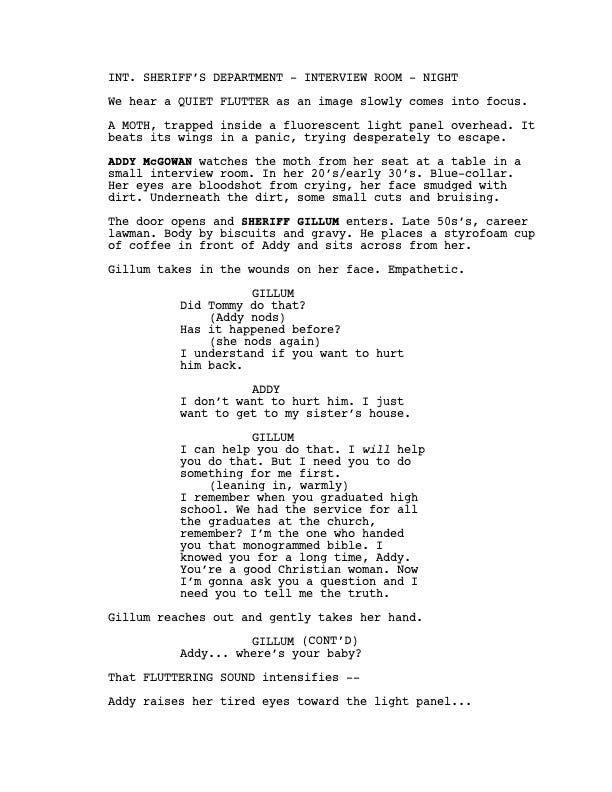I finished my first full draft of the pilot for HALF-LIGHT.
I think it’s pretty good? Question mark?
There’s a lot of work to do and one big creative decision to make before I jump into the rewrite. I’m only following two storylines in this episode, but there’s a third character I want to introduce immediately in episode two. Now I’m thinking about whether or not to add them as a runner in this episode, but I don’t want to slow the pace or dilute the impact of the stories I have now.
I’m going to give it a rest for a few days and come back with fresh eyes.
Last week I walked the picket line for a bit with one of my Start With 8 mentees. She’s in the middle of working on a new pilot and asked how I generally approach the structure. I told her a few key things that I’m always thinking about while I break that first hour and I thought I’d briefly retrace my steps with HALF-LIGHT since it’s fresh in my mind. These are some key things that stuck out on my read through.
As always, this is not a how-to, just how I’m currently working. YMMV. Hopefully there’s something in here that sparks a new idea or shakes something loose for you.
I talked about the inspiration for this idea a couple of years ago but to recap, the initial hook came while I was driving around at night, listening to Kate Bush’s The Ninth Wave concept album about a woman stranded at sea. The first section of the song, “Hello, Earth” says:
Hello, Earth
Hello, Earth
With just one hand held up high
I can blot you out, out of sight
Peek-a-boo, peek-a-boo, little Earth
With just my heart and my mind
I can be driving, driving home
And you asleep on the seat
I get out of my car
step into the night
And look up at the sky
And there’s something bright
traveling fast
Just look at it go
Just look at it go
In my head, I saw a young mother driving with her child in the car seat, having an encounter with a strange series of lights. My next what if was, “What if she blacks out during the encounter and when she wakes up, the baby is gone?”
Within a couple of hours I had the basic hook. A young mother is fleeing a domestic violence situation with her baby, driving through a national forest in the middle of the night. She has a mysterious encounter with a strange series of lights, the baby goes missing, and she becomes the primary suspect in its disappearance. She sets out to find her son and unravels a much larger mystery along the way.
When I wrote EXTANT, the thing that was most exciting to me was giving an extraordinary human being — a highly trained, fiercely intelligent astronaut — an impossible problem.
With HALF-LIGHT I went the opposite direction. I wanted to write someone who was younger, who wasn’t a scientist, someone less confident, the kind of person who is easy to underestimate. That led me to setting the story in Appalachia, or at least part of the story. Appalachians are often underestimated. They’re also resourceful and stubborn as hell. This lead is tough as pig iron, even if she doesn’t believe it herself when the story starts.
When I started to think about this as a series I knew I had a lot of sequences that I could pull from the feature spec but I had to re-break them into a pilot story. One of the easy pitfalls when you’re writing a pilot is to spin your wheels until the big event happens at the end of the episode that sets the rest of the series in motion.
I always want to have something that activates my characters early on and gives them agency. I give them a goal and let them drive the story (and reveal character) with their actions. Then something has to happen midway through that spins the story in a new direction. By the end, I want to land the premise. Essentially, “This is the contract I’m signing with you, the audience. This is the show you’re going to get.”
For HALF-LIGHT, the early scenes were pretty easy. In the first ten pages I focused a lot on characterization — how do I take all of that character information I told you about a couple of paragraphs ago and communicate that in the most interesting and emotional way — and posing a big dramatic question.
In one of my first acting classes in college I remember reading about three of the ways we learn about a character. 1) What are they doing? 2) What do other characters say about them? 3) What do they say about themselves?
Whenever I was cast in a show I would go through the script and write down the answers to all of these questions. By the time I started writing they were ingrained in me, like the other three important dramatic questions: “What do I want? Why do I want it? Why does it have to be now?”
I’m thinking about all of those questions in the early pages.
In the past couple of years I’ve added, “Why will the audience care?”
Here’s the scene breakdown for the first ten pages of HALF-LIGHT:
Interrogation scene with the Sheriff that raises the big dramatic question.
A scene to establish the connection between the lead, Addy, and her baby, Gabe.
A scene between Addy and her husband, Tommy. The final straw.
Tommy goes to work his midnight shift, Addy packs Gabe into the car, calls her sister, “I’m on my way.”
Drives through town, very carefully, doesn’t want anybody in the small town to see her.
Finally, she’s out of town, deep in the national forest, where she has the encounter.
Every one of those scenes has an important job and they’re all written to provoke an emotional response. There’s no shoe leather or filler, no scene where somebody’s just going about their day waiting for some external element to activate them. I wanted to grab people from the first few seconds and keep them.
Gabe’s abduction happens on Page 10, which sets up Addy’s big goal for the series. I still have forty pages to fill before the end of the pilot. What is “the pilot story?” She’s taking action, she’s doing everything she can to look for him, what changes by the end to send her in a new direction?
I needed a logline for the simple emotional story in the pilot episode. (I have found that these are also really helpful in story areas for your producing partners. If you put it in the first paragraph it gives them a context for everything that follows.)
One of the things I didn’t mention earlier (but that is set up in the characterization in the first ten pages) is that Addy, in the opening of the pilot, is a devout Christian. After Gabe goes missing, there’s a time jump, and when we meet her again she’s an atheist. She spent her whole life believing, doing the right thing, serving others, serving God, and then the very worst thing that could happen to her did. No matter how hard she prayed, God didn’t answer.
On page 11 she’s a woman who has lost her faith. She doesn’t believe in anything she can’t see, hear, or touch. Later, when someone else asks her to consider that there may be a supernatural or paranormal element to Gabe’s disappearance she shuts it down. There has to be a rational explanation. Somebody did this to her.
Then something happen to her that defies explanation and she’s forced to consider an alternate path to finding her son.
My logline for my emotional story for the pilot is, “A woman who lost her faith takes the first step toward believing there is more to the universe than what she can see.”
Having that logline helped me break the rest of the pilot story. From there it was all about driving to that end point, staying on that spine, leading her to take the tiniest leap of faith into this whole other world.
I know it helps to see examples, so here’s the first page of HALF-LIGHT. You can see some of the characterization tricks here. We don’t see her take any action, yet, but we get a sense of who she is through what the sheriff is saying to her and about her. And you can see that by the end of the page I’m trying my hardest to get you to turn to the next one. This is still an early draft, subject to change, but this is the basic idea.
Before I go, I just wanted to say how inspired I was by ACROSS THE SPIDER-VERSE. I thought it was spectacular, in every sense of the word. I’m so down for this wave of maximalist art. It’s unlike anything I’ve ever seen. I highly recommend it, I’m going at least two more times while it’s still in the theater.
That’s it for this week.
If you see me on the picket line, please say hello!






This is incredibly helpful and inspiring, as usual!
Love that first page. Let me know if you'd like feedback on this draft, happy to read it.